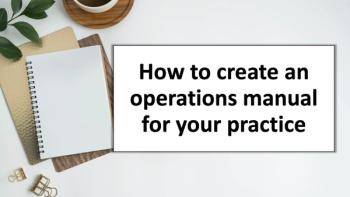
Simplify Your Scheduling
What happens in your practice when there aren't enough new patients to fill those three
What happens in your practice when there aren't enough new patients to fill those three "new patient" slots on your appointment schedule? Or when you can't accommodate all the requests for acute visits (think flu season) because they're going to run over into the slot you always set aside for a physical? And where is that patient who needed the physical, anyway?
If appointment slots are going unfilled, patients are waiting too long to be scheduled, and your staff is getting frustrated, it may be time to reconsider that old, rigid scheduling template.
According to Elizabeth Woodcock, FACMPE, a practice management expert and director of knowledge management for Physicians Practice, access is the name of the operational game these days. Patients have choices; if they can't get in to see you when they need to, they will go elsewhere. And a scheduling template loaded down with appointment types becomes a huge barrier to access.
Woodcock cites one extreme example: a practice she visited that had 1,100 appointment types - a scheduler's nightmare, to be sure. "How can 1,100 appointment types reflect what patients want?" asks Woodcock. "They just want to be seen. This level of complexity is unnecessary; there's no value added."
And why do practices designate appointment types, anyway? "Every doctor feels they need to define their supply," says Woodcock. "But it gets out of control with multiple docs in a practice. They don't want the same types as their partners. People don't stop and ask, 'Why are we doing this?' No one questions it."
Maybe practices should. After all, as Woodcock says, having too many appointment types "negatively affects productivity and deflects demand. They don't often match what the patient is demanding and you are supplying."
Serve your patients first
Howard Haft, MD, of Maryland Healthcare Associates in Waldorf, Md., says his practice has "gone through a real evolution with regard to scheduling. We've gone from feeling very smart about being able to customize many different appointment types [according to] the physician and the patient's particular problem, to just saying, 'Yes, we can get you scheduled,' and having extremely limited numbers of appointment types. It's been a very happy and positive transition in terms of enhanced efficiency."
Haft firmly believes that "trying to force patients and staff into an infinite variety of customized appointment types only confuses the process of getting the patient in to see the doctor. Usually you wind up with a confused patient, a confused staff member, and a frustrated physician," he says. "Is this what you want, or do you really want to be able to see your patients and not have gaps and overlaps in your schedule?"
The key to streamlined scheduling is to put patients' needs first. Haft admits that, for some physicians, that's not always easy. During medical training, he says, a recurring theme is that "the world revolves around us, and we'll come up with our own set of needs that we feel is important for the patients. And making that transition to asking the patient what's important - do they really care about these custom schedules, or do they want to get in and out? - it's a big culture shock." But, he says, "We are all capable of change."
Brian Easton, MD, of Highlands Family Medicine in Lebanon, Va., hasn't had to make such a change. He's been in practice for two and a half years, and has never worked in an office that used multiple appointment types. But he agrees that the patients' needs should be the priority.
"There's just not much utility in pigeonholing the different slots in your schedule. It doesn't mean much to the patients, and truthfully, it doesn't mean much to the physicians, either. What does it matter if you need a physical or have a runny nose?" he wonders.
Many physicians respond by saying that different patient problems tend to take up different amounts of time. So how can you be sure your schedule is allowing enough time to meet patients' needs without leaving you either backlogged or twiddling your thumbs waiting for the next patient?
Making the time work
The answer probably varies somewhat from practice to practice, but Woodcock recommends limiting the number of appointment types on your schedule and basing them on 10- or 15-minute blocks. She suggests no more than five appointment types. Examples may include new patients (set aside 30 minutes); patients with acute problems (10 minutes); an established patient (15 minutes); procedures (60 minutes); or "other - like a prenatal visit or an immunization" - (five minutes). Appointment times may be longer for certain specialties.
Haft says in his practice, "We've moved toward experimenting with open access, so every provider has some open appointments during certain periods of the week. We're using much more of that technique, and it's certainly the simplest."
He admits that, at Maryland Healthcare Associates, there are two types of appointments that are distinct from all the others.
"One is people coming in for a complete physical exam. We encourage them to come in during nonpeak seasons, and we limit them in numbers then. The other exception is people who need procedures that are dependent upon equipment or room availability, like sigmoidoscopy, treadmills, Dexa scans. Those we schedule around the room availability, knowing they do take a certain amount of staff time. Those are not given to open access."
Making good use of the time allotted for each appointment may tend more toward art than science. "When we know more people are coming in, skillful and experienced providers can speed up a little bit and accommodate patients without anyone feeling shortchanged," says Haft.
"We're not trying to see people in five minutes. But it's the quality of the interaction with the physician - if they engage the patient quickly, spend a few minutes listening to their complaints, make good eye contact, and address the problems in a compassionate way, they can do it more quickly than the 15 minutes usually allocated."
And in this 20-physician practice, patients and physicians are able to establish good, long-term relationships that foster efficiency. "We experimented with the clinic model where patients just saw the 'next available barber,' so to speak," says Haft, "but that was not a happy experience. Providers and patients were seeing people they didn't know and didn't have an intimate relationship with. It was a very inefficient system. Unless there are extenuating circumstances, we have the physicians paired up with their own group of patients."
At Easton's practice, "We have just one appointment type, a 15-minute slot. There's no magic number, it's just what works for us. Every patient, whether they have a runny nose or congestive heart failure, gets 15 minutes. Certain procedures, like a flex-sig - even that takes about 15 minutes anyway, and most of that is nurse time . ... But if we have a longer procedure, like a LEEP, we use two 15-minute slots. We don't run over very often."
But the amount of time isn't what matters most, Easton believes - again, quality
is important. He urges physicians who feel stifled by set appointment times to look at it another way.
"Some physicians complain that, 'If I can only see three or four patients an hour, my productivity will go down and my reimbursement will go down.' But the studies show if you use that extra time to do extra care, like preventive maintenance, you can increase the level of the visit, and your actual productivity increases. It has to do with doing as much as you can during the visit," Easton says. "And you can code higher."
Be flexible
It's hard to break old habits. So even if your practice is still using multiple appointment types, you can still work a little more efficiently by being flexible.
The Chester Clinic in Chester, Ill., uses about 30 "reason codes" in their electronic scheduling program, according to practice administrator April Hagmeier. "When we print out our schedule or look at it on the computer screen, it'll have the patient's name, but it'll also give the reason code - why they're coming - and whether it's an adult established patient, an adult new patient, a procedure, and so on."
Why so many? "We have a schedule for our lab and for our nurses, too," she explains. "So they have reason codes of their own. For the labs, they have codes for a fasting or nonfasting patient, for example. For nurses, it might be 'blood pressure check.' Ten [of the reason codes] are specifically for physicians." Hagmeier adds that actual appointment types are broken down by adults and children, new and established patients, obstetrical visits and Pap tests, surgery-related (for example, post-op), and procedures.
She says the schedulers at the practice have "quite a bit of flexibility to make it work. It's in place for a reason. Specifically, the doctors have said, 'I only want so many new patients a day,' and the schedulers are pretty much aware of that. But they also know when it's appropriate to make an exception. If there's no new patient slot open and they need to put a new patient in, they can combine two slots to do that. I've worked for practices that say, 'Oh, you put a new patient in a Pap slot.' Well, here that's OK, because it takes the same amount of time."
Like many others, Hagmeier's practice finds that some degree of open access is a must.
The Chester Clinic keeps six slots in each doctor's schedule open for same-day appointments to meet the needs of their many rural patients who are frequently walk-ins.
"If we get in a bind and it looks like we need to use [the open slots], we'll schedule them one or two days before," says Hagmeier. "We know we're going to have walk-ins or emergencies. That's important to make sure you have some flexible time in the schedule."
So keep it flexible and simple - the two go hand-in-hand. "When you make it simple it allows for more flexibility," says Easton. "The schedule has to be simple so the front desk, the nursing staff, the physicians, everyone can follow it and be a part of it. A whole bunch of rules about when you can schedule people, when you can't, who comes in, who doesn't - it gets confusing." n
Joanne Tetrault, director of editorial services for
Physicians Practice, can be reached at
This article appeared in the March 2003 issue of Physicians Practice.
Newsletter
Optimize your practice with the Physicians Practice newsletter, offering management pearls, leadership tips, and business strategies tailored for practice administrators and physicians of any specialty.








